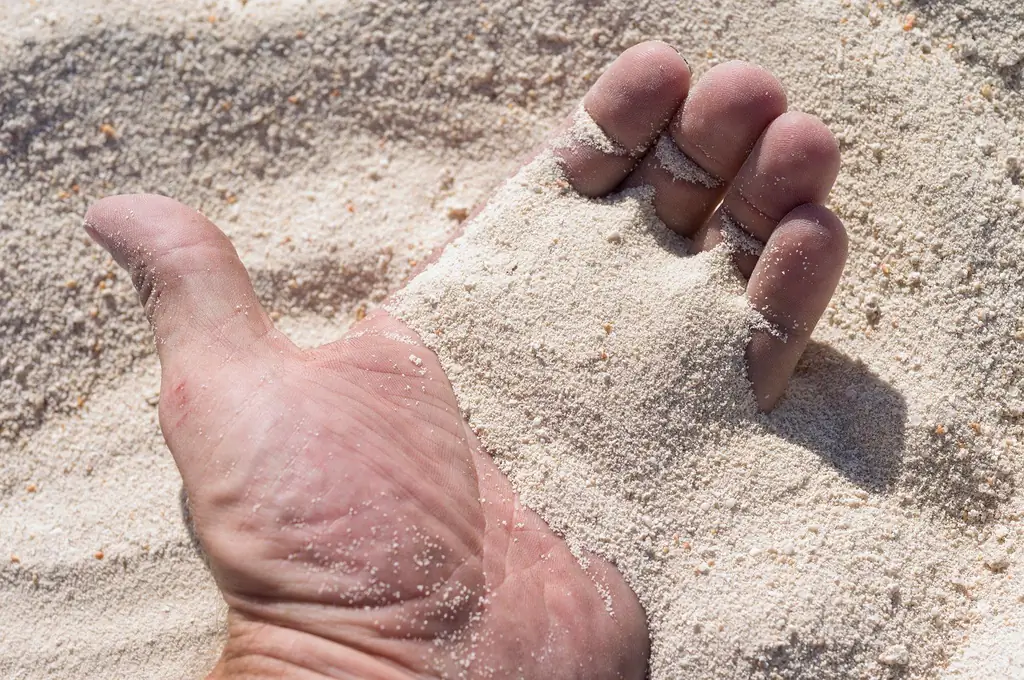
Table of contents:
- Author Bailey Albertson [email protected].
- Public 2024-01-17 22:26.
- Last modified 2025-06-01 07:32.
Dolomite flour: excellent harvest without chemicals

There are universal fertilizers that are of natural origin. With them, the harvest in the garden will always be good and environmentally friendly. One of these dressings is dolomite flour, which is made from rocks. How to use dolomite flour correctly?
Content
-
1 What is dolomite flour
- 1.1 Photo Gallery: Dolomite Path - From Mountain to Garden Area
- 1.2 Table: advantages and disadvantages of dolomite flour
- 1.3 Table: chemical composition of dolomite flour
-
2 Recommendations for the use of fertilizer depending on the type of soil
2.1 Table: rules for adding dolomite flour
-
3 Table: Compatibility of dolomite flour with various fertilizers
3.1 Video: dolomite flour in agriculture
- 4 Garden Fertilizer Tips
- 5 Analogs of means for use in the garden
What is dolomite flour
Dolomite (limestone) flour is crushed dolomite belonging to the group of carbonate rocks. It is produced in accordance with GOST 14050-93, according to which the particles do not exceed 2.5 mm; the presence of fractions up to 5 mm is allowed, but not more than 7%. Limestone flour is widely used in household plots to deoxidize soils and fight insects with a chitinous cover. For other living organisms, the agent is safe. Nevertheless, flour contains extremely small particles, work with it should be carried out in calm weather, protecting your eyes and respiratory tract if possible.
Photo gallery: dolomite path - from mountain to garden plot
-

Dolomite - Dolomite - rock
-

Dolomite flour - Dolomite flour is produced on an industrial scale
-

Dolomite (limestone) flour - Dolomite (limestone) flour can be white, gray and even orange
-

Packaged and granulated dolomite flour - Dolomite flour is packed in bags
Dolomite flour is sold in stores, packaged in 5 or 10 kg, has a white or gray color. During its production, no third-party chemical elements are mixed, since dolomite itself is useful.
Table: advantages and disadvantages of dolomite flour
| Advantages | disadvantages |
| With prolonged exposure to the soil, it improves its chemical and biological properties | Not suitable for all plants |
| Increases the efficiency of other applied fertilizers | Overdose is dangerous |
| Stimulates the processes of photosynthesis | |
| Binds harmful radionuclides, makes the harvest environmentally friendly | |
| Enriches the soil with calcium necessary for healthy root growth | |
| Destroys the chitinous cover of insects | |
| Safe for living organisms |
Table: chemical composition of dolomite flour
| Element | Percentage quantity |
| Dry matter | 91.9% |
| Calcium oxide (CaO) | 30.4% |
| Moisture | 0.4% |
| Magnesium oxide (MgO) | 21.7% |
| Carbon dioxide (CO2) | 47.9% |
Recommendations for the use of fertilizer depending on the type of soil
The rates for the introduction of dolomite flour depend on the chemical and biological composition of the soil in the country or in the backyard. One square meter requires:
- with acidic soil (pH less than 4.5) - 600 g,
- with moderately acidic soil (pH 4.6-5) - 500 g,
- with slightly acidic soil (pH 5.1-5.6) - 350 g.
For maximum effect, limestone flour is evenly distributed over the entire area and mixed with the soil (about 15 cm from the top layer). You can simply scatter the product over the ridges, in which case it will begin to act no earlier than in a year. Dolomite does not burn plant leaves. Its action at the correct doses is 8 years.

The introduction of dolomite flour on the ridges is best done in the fall.
There are plants that grow on acidic soils and therefore can die from the presence of dolomite flour in the soil. According to their responsiveness to the introduction of such fertilization, crops are divided into four main groups:
- They do not tolerate acidic soils, plants grow well on neutral and alkaline, respond positively to the introduction of dolomite, even on slightly acidic soils. Such crops include: alfalfa, all types of beets and cabbage.
- Sensitive to acidic soil. Plants of this group prefer neutral soils and respond positively to the introduction of limestone flour even on slightly acidic soil. These are barley, wheat, corn, soybeans, beans, peas, beans, clover, cucumbers, onions, lettuce.
- Weakly sensitive to changes in acidity. Such crops grow well in acidic and alkaline soils. Nevertheless, they respond positively to the introduction of dolomite flour at the recommended rates for acidic and slightly acidic soil. These are rye, oats, millet, buckwheat, timothy, radish, carrot, tomato.
- Plants that need liming only when the soil is acidic. Potatoes, for example, when dolomite flour is applied without the recommended amount of potassium fertilizers, can get scab, the starch content in the tubers decreases, and flax can get calcium chlorosis.
Table: rules for adding dolomite flour
| Plant | Period | amount |
| Stone fruits (plum, cherry, apricot) | After harvest, annually | 2 kg per tubular circle |
| Black currant | September, every two years | 1 kg for a bush |
| Cabbage | Before boarding | 500 grams per 1 sq.m. |
| Potatoes, tomatoes | When digging soil in autumn | Depends on soil acidity (see above) |
| Gooseberry, blueberry, cranberry, sorrel | You can not make | - |
For the rest of the garden crops, dolomite is applied two weeks before planting in quantities depending on the acidity of the soil.
Dolomite flour in greenhouses is distributed over the ridges in the amount of 200 g per 1 sq. M. Only, unlike open ground, the soil is not dug up in this case. Dolomite creates a moisture-retaining film.
The two most popular methods of liming the soil are known. They are named after their agronomist developers:
- Meatlider method. Instructions: for 1 kg of dolomite flour, take 8 g of boric acid powder, distribute over the ridges, dig up. A week later, mineral chemical fertilizers are applied and dug up again. Suitable for open ground.
- Makuni way. Mix 2 liters of soil from the ridge, 2 liters of a special substrate for a specific culture that is being prepared for planting, 2 liters of sphagnum moss, 1 liter of river sand, 4 liters of peat, then first add 30 g of dolomite flour, then the same amount of double superphosphate and two glasses of crushed charcoal, mix everything thoroughly. Suitable for preparing soil mixtures for indoor flowers or for growing crops in greenhouses and greenhouses.
Table: compatibility of dolomite flour with various fertilizers
| Fertilizer | Compatibility |
| Manure | Cannot be contributed together. First, flour, and after a few days, manure. Reduce its quantity by half. |
| Urea | Not compatible |
| Ammonium nitrate | Not compatible |
| Copper sulfate | Works great together |
| Boric acid | Well compatible |
| Superphosphate | Incompatible |
| Ammonium sulfate | Incompatible |
| Nitrophoska | Incompatible |
| Azofoska | Incompatible |
Video: dolomite flour in agriculture
Fertilizer garden tricks
- If the soil on the site is clayey, dolomite is applied annually. In other cases, it is used once every three years.
- Fertilizer is best applied in autumn so that the soil is rested and nourished with all useful elements.
- In spring or early summer, plants can be watered with a mixture of water and dolomite flour (200 g per 10 liters of water).

Dolomite flour under trees is applied along the perimeter of the near-stem circle
Analogs of the means for use in the garden
Dolomite flour is not the only agent that can be used to deoxidize the soil; it can be replaced with other compounds.
Wood ash. It is also successfully used to lower the acidity of the soil. But here you need to take into account the type of wood from which the ash was made, it is very difficult to calculate the required amount for deoxidation, especially over large areas. In any case, its consumption is several times higher than that of dolomite, therefore, the procedure is more expensive.

Wood ash is a costly soil deoxidizer
Lime (fluff). It is very active, quickly leads to the neutralization of the soil, prevents crops from absorbing phosphorus and nitrogen sufficiently, so it is better to apply lime in the fall for digging. In no case should it be poured onto the plant - the fluff causes a burn on the leaves. And an excess of slaked lime leads to serious root damage.

Lime causes burns on plant leaves and roots
Thanks to dolomite flour, you can get a safe, tasty, rich harvest. This is an economical but effective way to enrich the soil of a garden plot with useful microelements, without the need to fear damage to plants.
Recommended:
Chamora Turusi Variety Of Garden Strawberries - Features, Care And Other Important Aspects, The Difference Between Strawberries And Garden Strawberries + Photo

Everything about the Chamora Turusi strawberry variety: from planting and care to picking berries. Productivity, terms of fruiting, reviews of gardeners
Fences For Garden Beds With Your Own Hands - How To Make A Fence For A Front Garden, Flower Garden Or Vegetable Garden, Step By Step Instructions With A Photo

Options for fences for a suburban area. Their pros and cons. How to install a holder for plastic bushes, a flower bed from bottles: step by step instructions. Video
How Does Pancake Flour Differ From Ordinary Flour And Is It Possible To Make It Yourself

How is pancake flour different from ordinary flour? The composition of pancake flour, its use in cooking. Can you make pancake flour yourself
Antigadin For Cats: Instructions And Indications For Use, How To Use The Spray Correctly, Reviews, Cost And Analogues

Forms of release of funds Antigadin. What is it for and how to apply it. Advantages and disadvantages, comparison with analogues. Folk remedies "antigadins". Reviews
What Can Be Planted In June In The Country: Plants For The Garden, Vegetable Garden And Flower Garden

Plants suitable for planting in the garden in June are greens, roots, other vegetables, flowers. What can be planted in open ground and in a greenhouse. Gardener's recommendations
